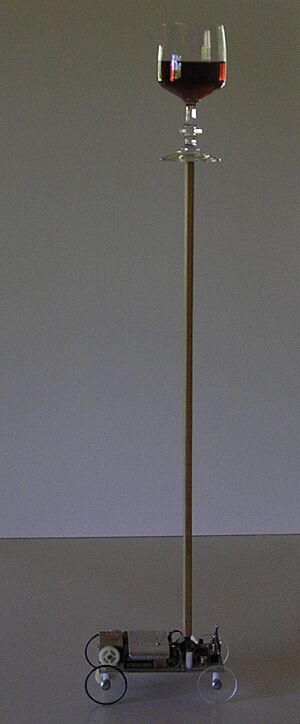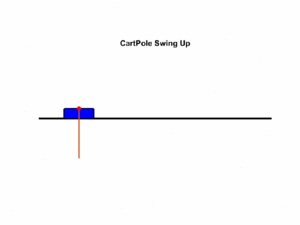Inverted pendulum facts for kids
An inverted pendulum is like a normal pendulum, but it's flipped upside down. Imagine trying to balance a broomstick on your finger – that's an inverted pendulum! Its heavy part (called the center of mass) is above its pivot point, which makes it very wobbly and ready to fall over.
To keep an inverted pendulum standing, you need a special "control system." This system constantly checks the pole's angle. If the pole starts to lean, the system quickly moves the bottom (the pivot point) back under the pole's center. This keeps it balanced and upright.
Scientists and engineers use the inverted pendulum as a classic challenge to test how well their control systems work. One common setup is called a cart and pole. Here, the pole is attached to a cart that can move back and forth. An electronic system controls the cart's movement to keep the pole balanced.
While a regular pendulum hangs down and stays stable, an inverted pendulum is naturally unstable. It always needs active help to stay upright. This help can come from moving its base, twisting it at the pivot point, or even shaking its base up and down very fast.
Another type of inverted pendulum is used in tall buildings. It's called a tiltmeter. This device has a wire anchored at the bottom of the building. The wire connects to a floating object in a pool of oil at the top. It helps measure if the building is leaning or moving.
How an Inverted Pendulum Works
Imagine a regular pendulum, like a swing. When it hangs straight down, it's in a stable position. It stays still because no forces are trying to turn it. If you push it, it swings back to this stable spot.
Now, picture an inverted pendulum. Its heavy part is directly above its pivot, like a broomstick balanced on your finger. This is an unstable position. Even a tiny nudge will make it fall over. This is because gravity pulls it away from the upright position.
To keep it balanced, a feedback control system is used. Think of it like your brain and muscles when you balance. The system constantly watches the pendulum's angle. If it starts to tip, the system quickly moves the pivot point sideways. This action brings the pivot back under the pendulum's center, keeping it upright.
The inverted pendulum problem is a famous test for different control methods. These methods include PID controllers, neural networks, and fuzzy control. It helps engineers design systems that can balance things. For example, it's similar to how rockets or missiles are guided. Their center of gravity is behind their center of drag, making them unstable without active control.
You can see this balancing act in simple robots called balancing carts. It's also how personal transporters like the Segway PT and hoverboards stay upright.
There's another cool way to balance an inverted pendulum without a complex control system. If you shake the pivot point up and down very quickly, the pendulum can stay upright! This is called Kapitza's pendulum. If the shaking is strong enough, the pendulum can even recover from small pushes.
Everyday Examples
One of the best examples of an inverted pendulum is a human being! When you stand upright, your body acts like an inverted pendulum. Your feet are the pivot point. Without constant small adjustments from your muscles, you would fall over.
Your nervous system has an amazing, unconscious control system. It's your sense of balance. It uses information from your eyes, muscles, joints, and inner ear. This information helps your brain make tiny, quick adjustments to your muscles. This keeps you standing straight. Walking, running, or balancing on one leg makes this system work even harder.
You can try balancing a broom or a meter stick on your hand. This is a simple way to experience being a control system yourself!
The inverted pendulum idea has been used in many devices. Early seismometers, which measure earthquakes, used inverted pendulums. Their natural instability made them very sensitive to any ground movement.
Modern personal transporters like two-wheeled self-balancing scooters and single-wheeled electric unicycles also use the inverted pendulum model. These devices are naturally unstable. They rely on electronic control systems to keep them upright and moving.
Swinging a pendulum on a cart until it stands upright is a common challenge in robotics. It helps engineers learn how to control complex movements.
See also
- Double inverted pendulum
- Inertia wheel pendulum
- Furuta pendulum
- iBOT
- Humanoid robot
- Ballbot



